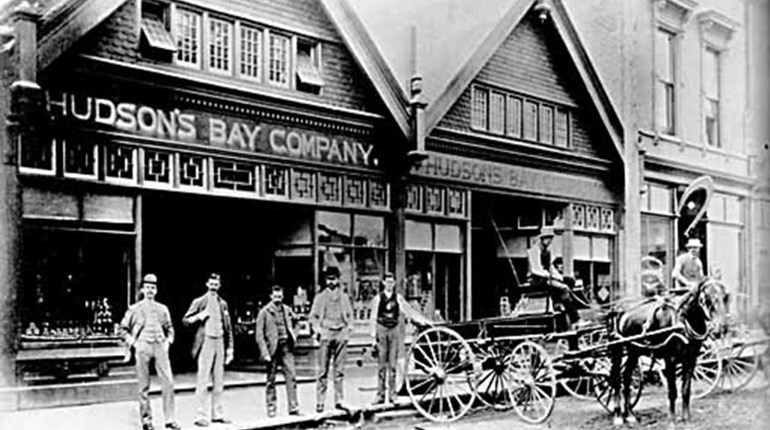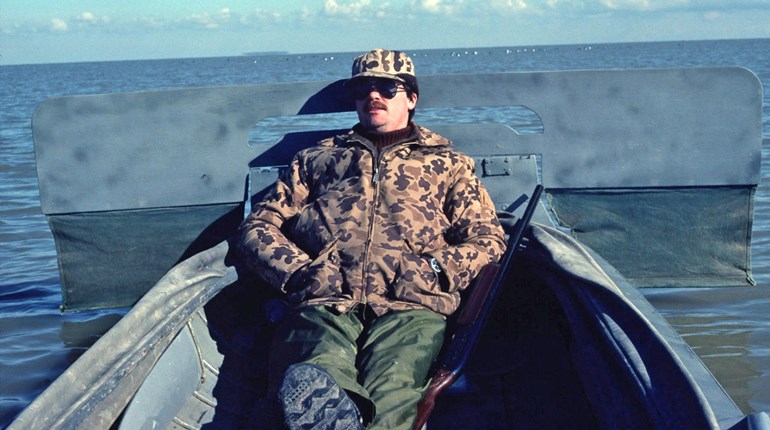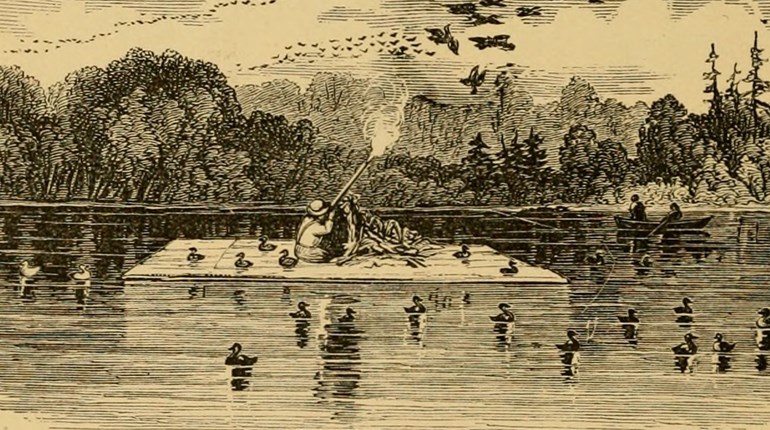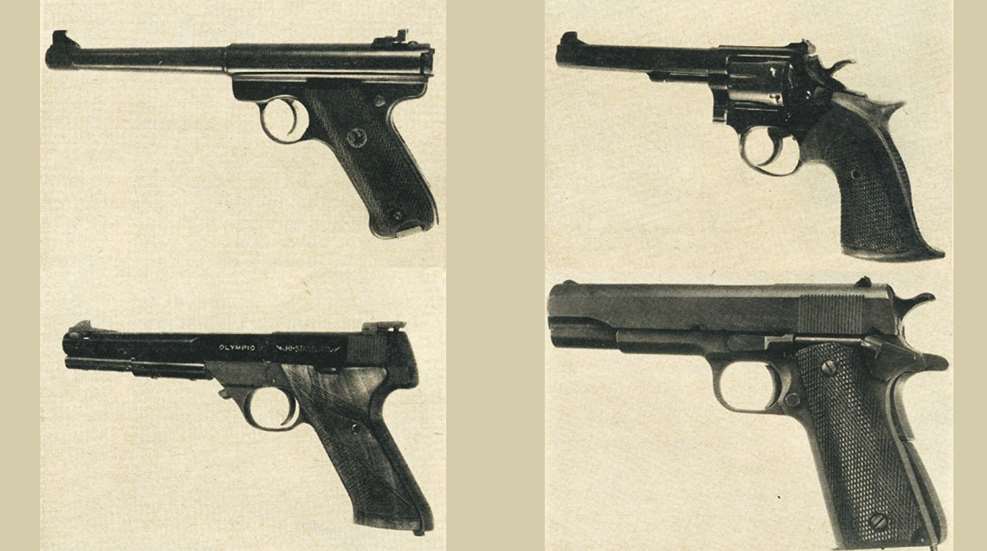
From the September 1956 American Rifleman, an explanation of and an introduction to competitive pistol shooting by Lt. Col. Jim Crossman. Part 2 of 2. Read Part 1.
Once you get bitten by the pistol bug, you want to rush out and buy a lot of equipment so you can start shooting hot scores. Most people, in their over-eagerness, end up with mediocre gear that they later have to foist off on some poor tyro. The good shot will perform well with almost any sort of equipment, while the dub will still be a dub with the finest of gear, but both dub and good shot will perform better with the right equipment. Don’t think, though, that the more money you spend the more 10s you will get. Equipment will help you up to a point, but finally you are the guy who has to do the hard part.
Let’s look at what you should have. Let’s begin by deciding that you should get your own stuff as soon as you can, even if on a most austere basis. No one will object to your trying their equipment to help you decide, but you may find considerable reluctance to letting you use it time after time.
“Get one, learn to shoot it, and you will find you have much more company.”
Your first piece of equipment should be your .22 handgun. This can be used for indoor and outdoor competitions, for teaching the kids or the gal friend how to shoot, and for tin-canning and general plinking. While there are many handguns on the market your choice at this writing will rapidly narrow down to three: the Colt, Hi-Standard and Ruger target automatics, with the revolver practically out of the picture. Target models of these pistols have heavy barrels and adjustable sights. Front sight should be a square blade about ⅛ inch or more in width, with a square rear notch to match. A good muzzle brake is a desirable accessory; it adds a surprising amount of stability to the gun and vies a little extra aiming time in rapid fire. Which one of the three pistols should you get? It doesn’t matter much. Get one, learn to shoot it, and you will find you have much more company.
Your second investment probably should be a spotting scope and stand of some sort. A fair-to-middling instrument will do, as its toughest job will be to spot .22 holes (remember they are less than ¼ inch) in the black at 50 yards or 50 meters. It should do this for you without strain, but anything more represents extra bulk, weight and cost. Now, before you put any money in a classy scope stand, let’s look ahead a bit. One of the things you will need eventually is a box for holding your pistols, ammunition and miscellaneous gear. The lid of this box can double as a scope holder and scope stand, so rather than buy a separate scope stand, put the money into a pistol box. You can buy one of the good commercial boxes or do-it-yourself at less expense. Building a box is fun, but is a separate subject all by itself, so look over the commercial and homemade boxes you see on the line, and copy the best features of each. Meanwhile, you can improvise some sort of simple stand for the scope.
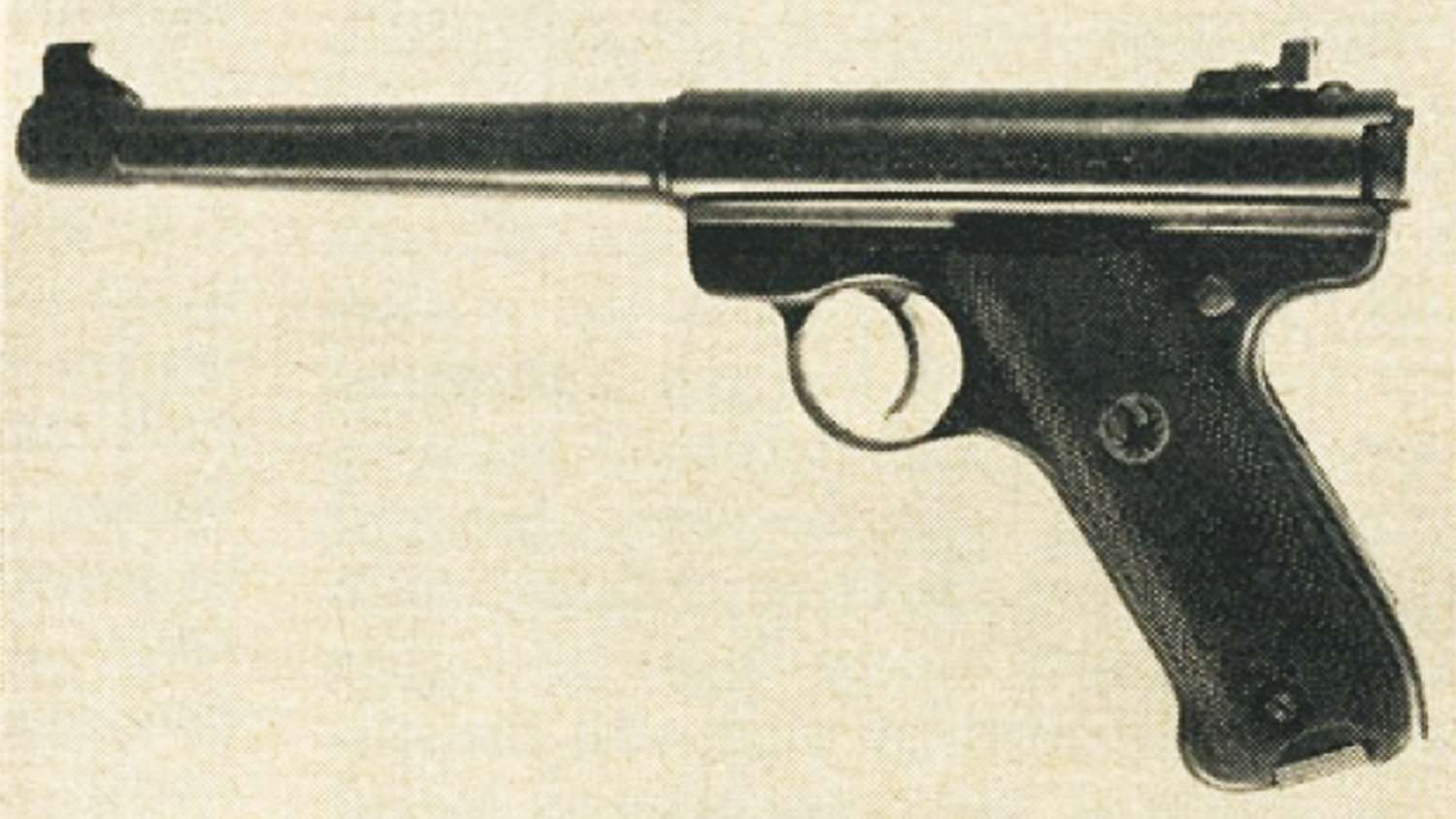
With a .22 pistol, a scope and a pistol box you are really in business and now you will be picking up those little gadgets you need—or think you need. A carbide lamp or other scheme for putting a dead-black coating on the sights, screwdrivers and other tools for making minor adjustments, earplugs, cleaning stuff, timer or watch, bullet hole gauge, wiping rag, etc.
The next big investment should be a handgun to shoot in the center fire matches. Having been thoroughly convinced in the .22 field that the only thing to consider is the autoloader, you start looking for a good match-type autoloader to shoot the center fire cartridge—and you won’t find any. Practically speaking, the gun used in the center fire matches is the revolver, either the Colt or Smith & Wesson match gun. And the cartridge for use in these matches is the .38 S&W Special. It has had years of work on it, and you can get very fine, reliable, accurate, light-kicking match stuff. The majority of guns on the line will be .38 revolvers, with a sprinkling of .45 autoloaders, .45 revolvers, and .38 autoloaders. Several gunsmiths will convert—at a considerable cost—the Colt .38 Super Auto to handle the .38 Special cartridge.
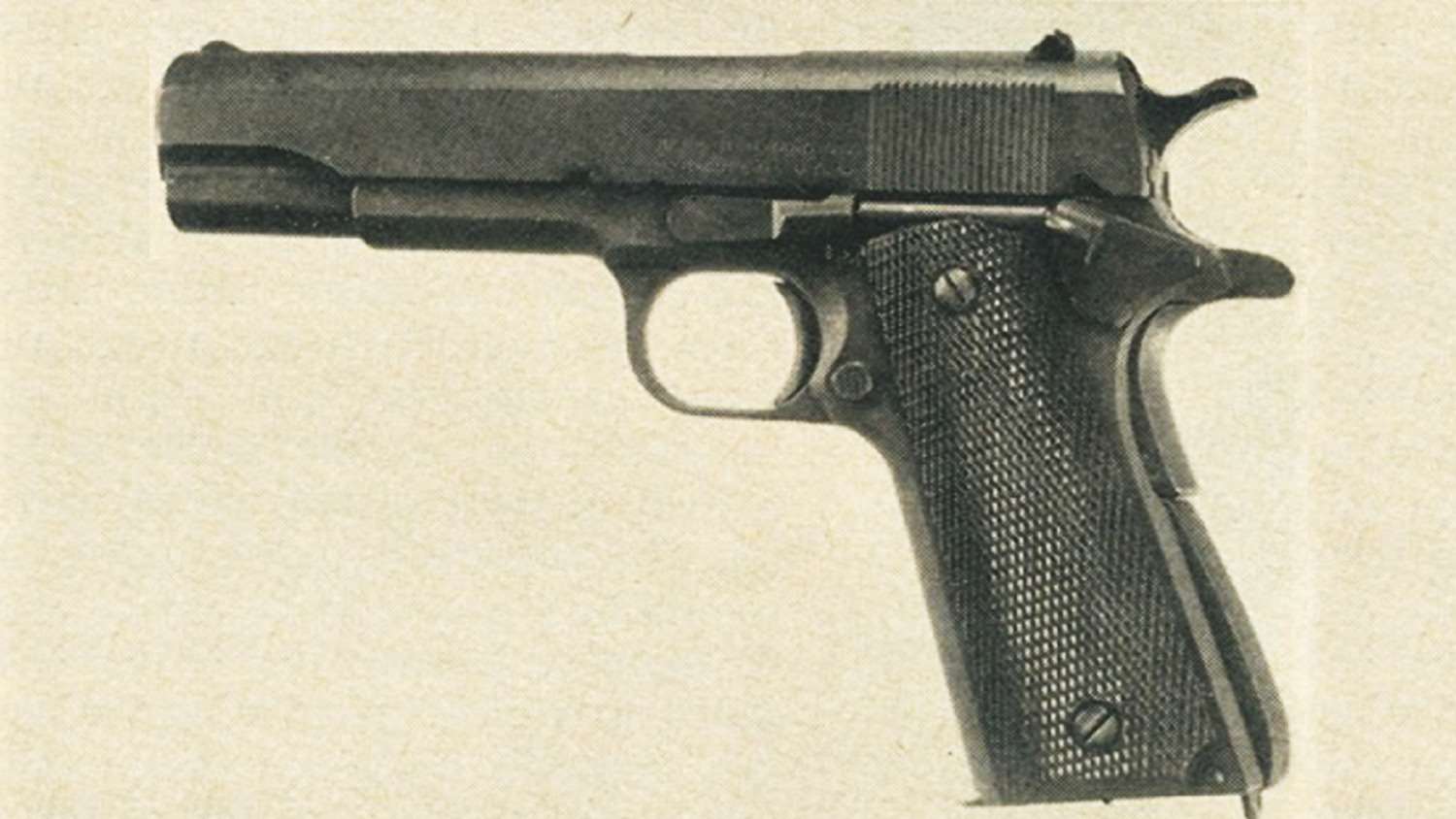
And this leads us to our third type of gun—for matches limited to the .45 caliber. The reason for this class, of course, is that the military cartridge is the .45. Now this business gets a bit complicated, so follow along carefully. In National and Regional matches sponsored by the National Board for the Promotion of Rifle Practice, and in many military matches, you must shoot the M1911 .45 auto-pistol, with standard grips. In most NRA-registered or approved matches any .45 handgun may be used, including the automatic with special grips, muzzle brake, and other refinements, or the .45 revolver. So you’re beginning to wonder why you can’t shoot the .45 gun in the center fire matches? Well, you can, and many people do shoot either the .45 revolver or the auto in both the center fire and the .45 matches. However, I think you’ll find that scores are likely to be higher with the .38 cartridge than with the .45.
If you’re a bit overwhelmed by all this equipment, you can buy only two guns and be able to shoot everything. The two would be the .22 auto and the .45 auto. The latter would let you shoot the NRA and National Board .45 matches, as well as the center fire matches but at a disadvantage in some of the stages. Your choice of a second gun will depend on the sort of matches you will be shooting, your purse, and your personal preference.
A couple of other specialized guns can be used in the International slow fire and rapid fire events, but unless you are mighty serious about these, you probably can get by very nicely with your regular .22 auto.
Let’s not get so involved in buying guns that we forget one of the pistol shooter’s most valuable accessories—a comfortable folding chair. This is not a so necessary indoors, where there is usually a place to sit. Outdoors there may be no good place to sit, a match may run over three days, and you really need a chair to keep you from getting worn out. Even when you go up on the line to shoot it is a good idea to take the chair with you. There may be many periods of a few minutes when you can relax between strings. One of the light, folding aluminum-and-canvas chairs is a good bet.
Your First Match
You’ve made your entry for this match, probably with a bit of fear and trembling, and have just arrived at the range, a complete stranger, so what do you do? First, find the statistical office and get your squadding ticket. The ticket will tell you what target (position on the firing line) you have drawn for each match. Move your gear to a place behind your first target number. Check to see what relay is then shooting—the range officer usually announces it frequently, it may be posted on a board on the range, or you might have to ask someone. Until your relay is called up, spend the time getting your equipment ready; check sight adjustment, blacken sights, wipe off excess oil, check your ammunition, load magazines, etc. When everything is in order, close up your box, sit back, relax, and see what’s going on. Listen to the range officer’s commands so you can get used to his or her peculiarities, watch target operation, and generally get the feel of the range.
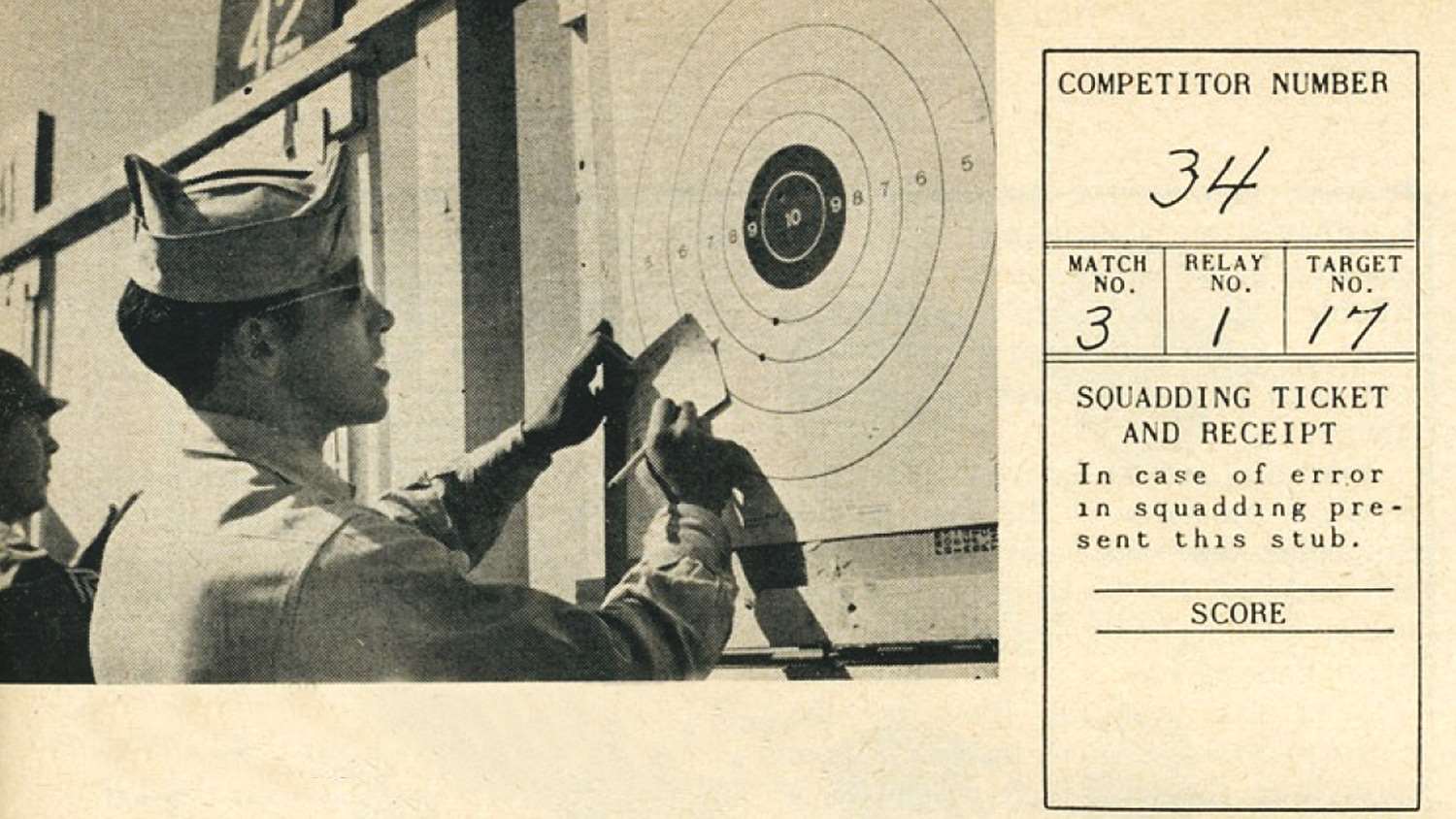
Listen carefully for the announcements and for your relay to be called, as you get no sympathy and no second chance if you miss it. Move promptly up to the firing line and set up your equipment. Drop your chair behind the line, put your pistol box on the shooting bench to the right of the number, and open the box. Get the scope focused on your target—and here’s a good time to double-check everything. Look at your squadding ticket again for relay and target number, see that you are set up on the right position on the line, and finally check that your scope is focused on your target.
While it is a great satisfaction to shoot a 10 any time, only the ones you put on your own target count for you. While shooting on the wrong target is a simple and fast way to lose points, another good way is to shoot on the right target but to have your scope set on the wrong one. You’ll find that the bullet holes don’t match up with your calls and you’ll wonder what is going on, because the corrections you make in sight and hold don’t seem to give the right results.
Being firmly assured that you are in the right place at the right time, and your scope is set correctly, get your other equipment handy. Look at the sight blackening job; load magazines, if not already done; get your watch or timer handy; put in your earplugs; get a good clean level place for your feet, and relax. Keep your squadding ticket handy, as the range officer probably will check it. If it looks as though there might be a considerable wait, sit down and take it easy.
When the commands are given, load up and start to work. In slow fire you are allowed one minute per shot (except in the National Matches Course where the allowed time is ½ minute per shot), but this doesn’t mean you have to aim each shot for 60 seconds. If you can’t get the shot off in a reasonable time—say 10 or 15 seconds—take the gun down, relax, and start all over again.
Too-long holding results in your running out of breath, your eyes getting blurry, your arm tiring, and a final fatal yank. On the other hand, if you have a good picture and aren’t wobbling around too much, put the pressure on the trigger and get the shot away. Keep an eye on your time. You are allowed the full time but nothing over, and there is no point in crowding yourself on the last couple of shots.
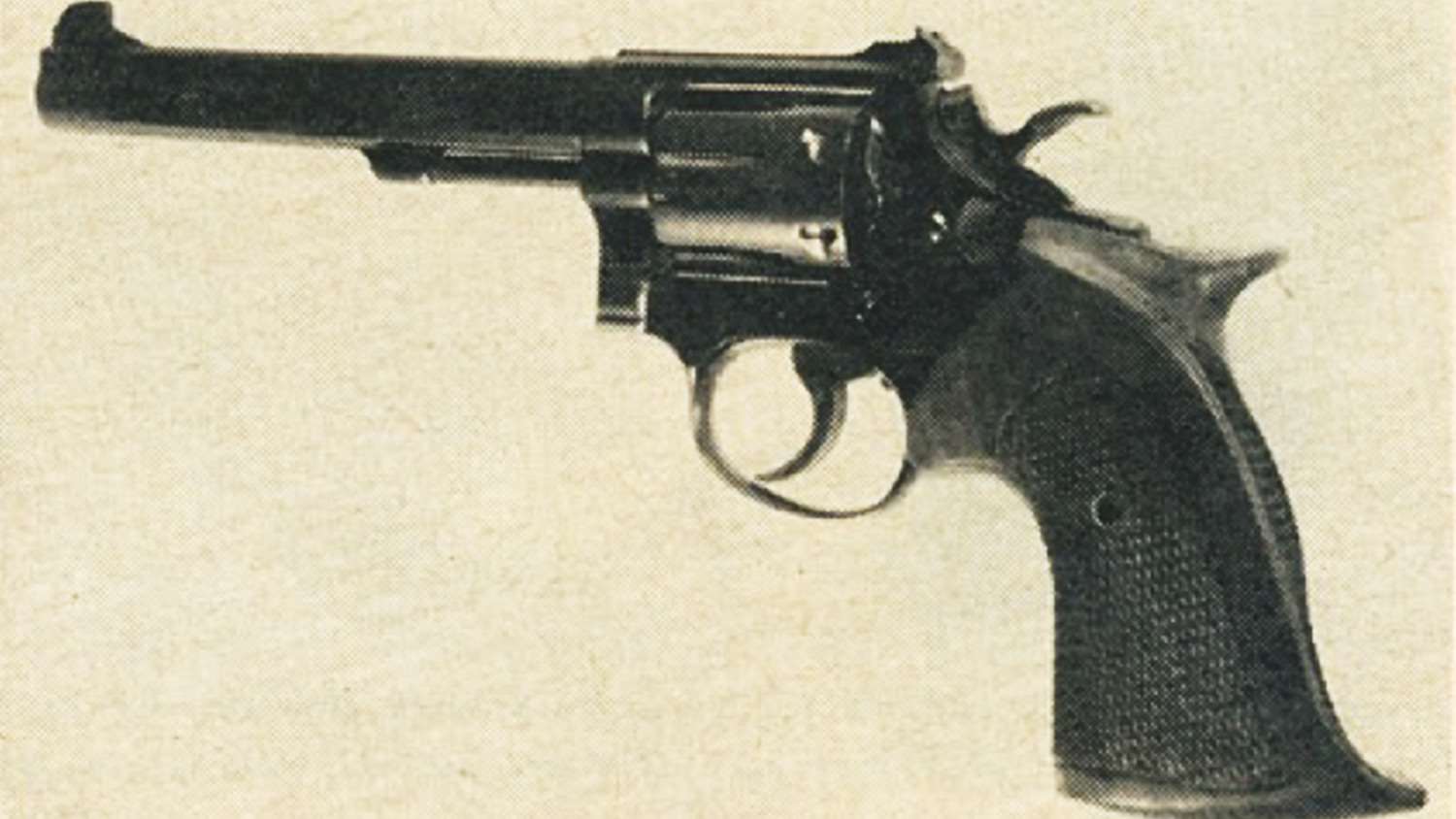
When you have finished the string, move back, sit down, and wait for the range officer to call for scoring. Outdoors you will move forward to the targets and watch the scorer doing his work. Keep your hands off the target until after it is scored, as your competitors may take a dim view of your making bullet holes larger or closer to the 10-ring. Paste the target or replace it, and then get back to your shooting position and ready to go on the next string. After you fire your last shot, put all your equipment away, and move the box off the firing line to make room for the next person before you go down to score. And after all scoring is finished, be sure to sign the score card.
When you are called up to fire timed or rapid fire the procedure is much the same except that you won’t need your timer or a scope, as there is no time to scope during a string and you will score after every string. In moving down from 50 to 25 yards in a three-stage match, many people take just the gun and ammunition.
Ammunition
You will find many stumbling blocks in the way to good scores, such as a shaky arm, poor eyesight, and so on. But one of the things you need not stumble over is poor ammunition. You can either buy or make your own ammunition to give you the characteristics you want.
There is no use considering making your own .22 rimfire ammunition. Only the factories can make this because of its ‘built-in’ priming. You can use the ordinary garden variety, or you can buy .22 match cartridges, which may give a bit better accuracy.
In the center fire and .45 caliber ammunition you want two things—most accuracy and least recoil. Special mid-range match ammunition can be bought, with light bullets loaded to give good accuracy and reduced recoil. As long as it is not so bad as to be unpleasant, recoil is only objectionable for two reasons; it is tiring, and it reduces time available for aiming in timed and rapid fire. In slow fire, recoil is not especially objectionable, but it does count in rapid fire, where you need all the time for sighting and trigger squeeze and where extra recoil means time wasted in recovering. Even on the .22, I find the muzzle brake gives me a bit more time. The .45 bounces around quite a lot with Service loads, so you want to use the lightest loads that will function the gun properly.
With a little experimenting, you can get a load that will give good accuracy and good functioning in your own gun. Handloading .38 and .45 stuff can result in lower costs, too.
Proper functioning of the gun-ammunition combination is a good part of high scores. If you have a malfunction in timed or rapid fire, you have to shoot another five-shot string on the same target with everyone watching you shoot by yourself; and to make it worse, only the low five shots count for score. This is enough to shake anyone, but you are allowed only one such ‘alibi’ string per match and if you get another malfunction, you can really be hurt in the score. Even if you don’t have more trouble, you are likely to worry about it.
While it’s always comforting to know your gun will put shot after shot through the same hole, you can waste money buying match ammunition (it is more expensive than the regular variety) if you aren’t capable of making use of it. An inch or so in ammunition capability isn’t going to help your scores much if you shoot foot-size groups. As long as your scores over the National Match Course run below 250, you need intelligent practice, not better ammunition. When you get up in the 270s or higher, than you need all the help you can get and match quality ammunition is indicated for big matches.
You may want to practice with one type of ammunition and shoot something else in matches. Follow the practice of the baseball player who swings a couple of bats before he gets up. Do your practicing with ammunition that gives at least as much recoil as the match stuff. Before you go to a match, be sure to shoot enough of the choice ammunition to be sure of your sight settings and gun functioning.
Using the Spotting Scope
While the spotting scope is a most useful accessory for the pistol shooter, it also is a most abused one, and a contributing factor to many poor scores. The glass is used to reveal where your shot went, and there are three reasons why you want such news. The first is to determine if your sight setting and sight picture are correct. If, for some reason, the scope shows that you are building up a group that is off center, then you want to double-check your sight picture, or make a slight change to center your group on the 10-ring.
The second reason for using the scope is to confirm the fact that you are squeezing the trigger. If your sight setting is about right and the picture looks good, but shots keep appearing in the wrong places, check right away to see that your scope is on your target. If it is, then you’ve got either ‘gun-trouble’ with the chances highly in favor of the ‘you-trouble’ with the chances highly in favor of the ‘you-trouble’. Wild shots are an indication that your let-offs aren’t good and you need to double-check your trigger squeeze.
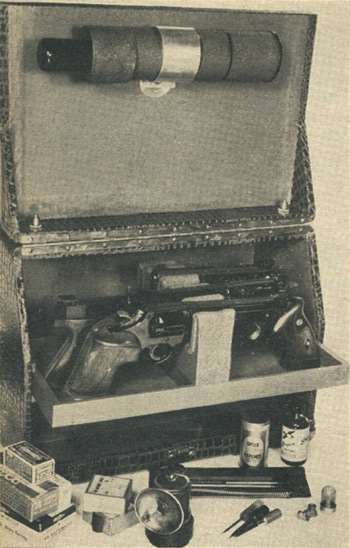
The third reason for using the scope is to see the value of the shot, so you can figure out what kind of score you are making. Pretty soon you realize you’re working on a hot one and you begin figuring out how a couple more 10s will let you beat Joe Blow for the championship—and suddenly there springs up this knee-high wind. It’s a most peculiar thing, this wind, it seems to affect only your legs, but it makes ’em shake and quiver until you get off a couple of wild yanks that wreck your score, whereupon the wind seems to die down again. Shooting’ and computin’ will lead to sure trouble! The only shot you can do anything about is the one in the gun. The shots already fired have punched their holes in the paper, and it is too late to do anything about them now. The shots coming up aren’t here yet, and there is no point in worrying about them until their turn. Nope, the only shot to worry about is the one ready to go. Instead of thinking about what a good score you are working on, or how you would like to beat Joe, think instead of sight picture and trigger squeeze.
If you are pretty sure of your sight setting and your sight picture and seem to be squeezing ’em off all right, forget about scoping for the rest of the string and spend the time concentrating on the sights and squeeze.
Ah yes, but then the time arrives when the scope shows that you are building up a good shot group just out of the 10-ring despite good holds and good calls. What do you do then? You have two good choices, and one not-so-good choice. The not-so-good is to leave things as they are, hoping the group will begin to shift in the right direction. But if you want to do something positive about putting the group where it belongs, you can either move the sights or hold off. I’ve shot alongside people who spent the whole time between shots screwing the sights hither and yon—and good scores they seemed to be making. My own choice, though, is to hold off for the string-to-string variation once I am fairly sure of my basic sight setting.
If you have adjustable sights, write down on a piece of paper the direction to turn the screws to move the sights a given direction and the distance one graduation will move you at a given range. This is especially important when you have several guns which may have different types of sights, moving different directions and different amounts. Paste that paper in a conspicuous place in the pistol box.
A Few Don’ts
There are several ways of achieving undesirable ‘fame’ in the pistol shooting game. They help neither your score nor your enjoyment. Learn these ways and then avoid them.
You can become known as that ‘late so-and-so’, if you have to be called and called before you get up on the line, if you are always the last one loaded and the last one back from scoring the targets. There’s a time for shooting and a time for talking—and the time for talking is not when you are supposed to be shooting.
If you are the talkative type you can easily achieve loud-mouth fame, if you stand behind the firing line vociferously commenting on the shooters, or if you holler up and down the line to your friends when they are shooting.
A variation, and almost as popular, is the complainer, who tells everyone in no uncertain terms just what is wrong with this shooting match, the location, the weather, the range, and the officials, and who always has alibis for his poor shooting. Ask him to help straighten out the mess he complains about? No sir, he hasn’t got the time to spare.
And then there’s the forgetful type, who doesn’t know how it happened, but he just plumb forgot it, and please could he borrow from you your smoke pot, telescope, screwdriver, and 10 rounds of ammunition?
The guy who views the world through the bottom of a bottle is a pain in the neck to everyone, and his name quickly gets spread around as one to avoid at all costs.
And we shouldn’t forget the rule-fudger, the guy who is always trying to take a little advantage just outside the rules. Some of these people have been very famous, to the point where a regular swarm of honest shooters stood around watching them every time they shot, just trying to keep them honest. Sooner or later these wise guys get found out, and are barred from the game.
I hate to mention this here, and it may be a silly thought, but you can become famous by being a good sport, knowing the rules and etiquette of the game, and shooting very good scores. Look around, and you will see a lot of these famous people. Me? Nah, I’m not famous, but I’m sure working at it as hard as I can.














